Letters to the Editor: City's removal of portable public toilets is failing its homeless communities

To the editor: The editorial on the city’s removal of portable toilets from homeless encampments made me think of a 50-year-old homeless woman I befriended two years ago, who has been living in a tent in a parking lot near the 134 Freeway offramp in Eagle Rock. There was a portable toilet there until a few days ago. In order to wash herself, she uses the bathroom in the park across the street. However, that restroom is closed on Sundays and at night. Without the portable toilet she has to walk a quarter-mile to the nearest gas station. If the restroom is not open there, she walks another quarter-mile to the nearest supermarket to use the restroom.
What is the city of L.A. trying to do to these poor people? Isn’t their situation hard enough? It’s not only cruel but also a health hazard to remove the toilets and sinks. Garbage collection is irregular in this encampment, rodents are a big problem there at night and now no toilets! Is it fine with the city that these people may have to urinate and defecate in the area where they live? This is not only inhumane but a public health problem as well.
Renee Klang, La Cañada
..
To the editor: Portable public toilets are being vandalized so the city decides to yank them all out, leaving the homeless with no bathrooms. Your editorial rightly points out that this is akin to throwing in the towel for a problem that gets worse by the day.
Yet, for many nonprofits, vandalism has never been an insoluble problem. They have dealt with it by setting up a registry, issuing IDs and limiting users. Supervision and maintenance costs can then be minimized with outside volunteers or self-policing by the homeless themselves.
The government ignores this possibility because it means getting more organizations and interest groups involved. Administrators prefer simple, straightforward, top-down decisions. This usually means throwing money at a problem and, if that fails, kick it further down the road.
It should be clear by now that the government cannot solve the homeless crisis without community involvement. Equally, charities without government backing will remain limited as to what they can accomplish. Instead of repetitive cycles of getting nowhere, government, charities, volunteer groups, communities and homeless groups all need to work together. Definitely messy and complicated, but what's the alternative?
Austin Tien, Hacienda Heights
This story originally appeared in Los Angeles Times.

